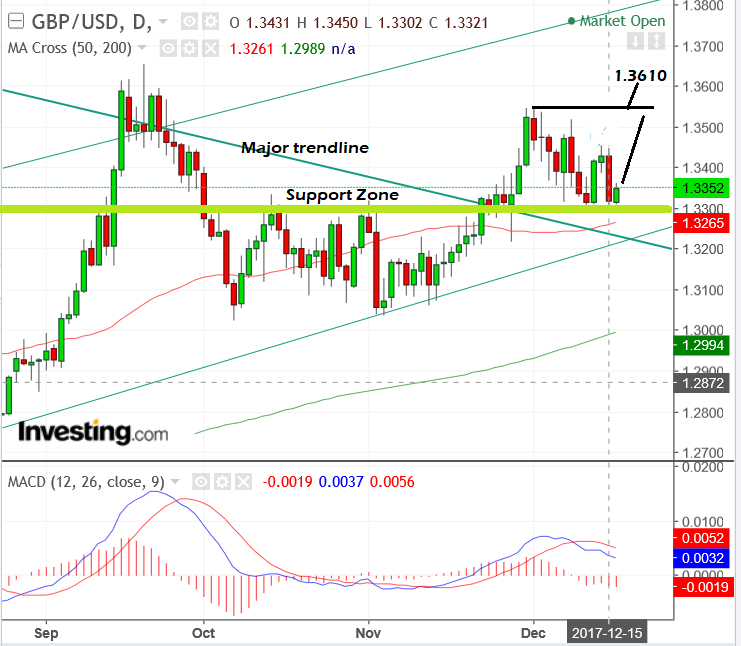Pound-to-Dollar Exchange Rate: Tech Analysis, News, and Events For the Week Ahead

The Pound will be sensitive to the next machinations in the Brexit imbroglio this week while the Dollar looks to tax reform for a boost. Charts suggest Sterling has the advantage.
A break above a major trendline, as recently occurred on the Pound-to-Dollar chart, is a major event for currencies from a technical analyst’s perspective because it indicates a changing in trend.
Since technical analysis is mostly about assessing the strength and direction of price trends, such an event constitutes an important moment for the currency pair in question.
The significance of the break is highlighted clearly on the monthly chart below, which shows a) how important the trendline is (it was drawn from the early 2014 peak) and b) the actual break itself.

Whilst there is no guarantee the downtrend has reversed into an uptrend, the recent break is a sign the downtrend is waning and assuming it can hold (at least until the end of January), recent price action could open the door to a substantial move higher. How far?
Well, according to technical lore, a break above a trendline will normally extend the same distance as the height of the move immediately prior to the break, which in this case we have assessed as the price movement marked with the red line 'a'.
Extrapolating that same distance higher gives a target of 1.4500-1.4600. Whilst it is too early to call a definite break at the current juncture, an upside bias is clear on the monthly chart.
Zooming into the daily chart, we note how the pair has consistently held above a major support line around the 1.3300 level, which is marked by the thick green line on the chart below.

This area has been highlighted by several analysts, including those at Lloyds Banking Group and Commerzbank, who have flagged how the exchange rate first struggled to break above 1.3300 last October and is currently resistant to a fall below it.
Taken together with the break above the trendline, we see the whole picture as supporting the case for a slow move higher rather than lower - first back up to the 1.3554 highs and then, assuming a break above them, to the next target at 1.3610.
The target at 1.3610 is just beneath the level of the R2 monthly pivot, which may prove a formidable glass ceiling, above which it could be difficult for the exchange rate to break.
Many technical traders expect a pull-back when prices reach their monthly pivot points and sometimes trade accordingly by placing short-term bearish bets on the exchange rate
This means selling activity tends to increase at the pivot, which leads to lower prices and, essentially, makes the pull-back a 'self-fulfilling prophecy'.
Data and Events for the Dollar
The Dollar is likely to trade according to the "whim of year-end flows and tax reform headlines" in the week ahead according to Kathy Lien, a managing director of foreign exchange strategy at BK Asset Management, since the economic data in the calendar is not seen as particularly biting.
Nevertheless, given concerns about inflation staying lower for longer and the implication of this for interest rates (which are important for currencies) personal consumption expenditure (PCE) data out Friday at 13.30 GMT will be watched closely. It is the Federal Reserve’s favoured inflation gauge.
Core-PCE is expected to have risen by 1.5% in November, when compared with the same period one year ago, which is up from the 1.4% growth seen in October.
The Core-PCE removes volatile food and energy items from the basket of goods whose prices are measured and so it is seen as a better measure of “underlying inflation pressures” for the US economy.
Personal Income and spending figures, which are important for inflation expectations, are also due out at 13:30 on Friday. Larger than expected gains, or surprise falls, in these numbers will have some an impact on the Dollar.
The Philly Fed manufacturing index, due out at 13.30 on Thursday, and Michigan sentiment measure on Friday are the final Dollar reports of note for the week.
Data and Events for the Pound
Front and centre in the week ahead for the Pound will be Brexit politics, with the cabinet set to discuss goals for phase two of talks in a key meeting requiring ministers to define the “end state” relationship the UK will pursue with Europe
"With a cabinet reshuffle imminent some may sound more conciliatory," says Canadian investment bank TD Securities in its weekly outlook.
Wednesday the UK parliament will vote on a further amendment to the Brexit bill, which is expected to put a firm departure date into legislation.
However, analysts are sceptical the government will get enough votes to push this through as opposition to the idea is pretty strong.
Rebels may be emboldened by their successful defeat of the government last week which, having passed “Amendment 7”, requires parliament to be given a “meaningful vote” on whether to accept the final Brexit agreement struck with Brussels.
From an economic data perspective, the main events are current account and business investment data, due out on Friday at 9.30 GMT, both of which are indicators that are peculiarly sensitive to Brexit and can impact the Pound.
The current account measures the difference between money flowing into and out of the UK. It most recently showed a deficit of £-23.2 bn.
Economists forecast this figure to fall to £-21.3 bn for the third-quarter. If the actual number falls even further then it may lift the Pound as it will show the deficit is narrowing faster than expected.
Business investment is expected to rise 0.2% for the third quarter, the same as it did in the previous three months. A greater increase would be positive for Sterling as it would suggest businesses are not holding back new projects as much as has been feared. Brexit uncertainty has been a key influence on business investment of late.
Get up to 5% more foreign exchange by using a specialist provider by getting closer to the real market rate and avoid the gaping spreads charged by your bank for international payments. Learn more here.
